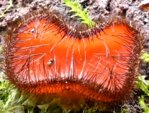By Gary Gilbert
Mushroom hunting as a hobby has taken off in popularity in recent years, and so has the art of mushroom photography, the art of photographing very small, quirky, and colorful fungal fruiting bodies in the woods. Many of us walk in the woods and casually snap a photo of a brightly colored mushroom and are happy as a lark, or a toadstool, as the case may be. These photos, especially with modern cell phones, can work out just fine to capture the moment or be sent out through social media. However, if you desire to enlarge your images or print them, it is best to have a good camera and a good technique. It is better still to use a tripod for longer exposures or while taking multiple photos, which you later compress into a single image; a technique called “photo-stacking”.
When you shoot a picture of your daughter in a soccer game, you can clearly see all the players, the grass, and probably the bleachers, like what you see with the naked eye, but if you shoot a photo really closeup of a mushroom, the opposite will be true. Often you will have a clear image of the cap, but the far edge of the cap or the gills will likely be out of focus. This range of focus is called the depth of field, and it is the biggest stumbling block in good closeup, or ‘macro’, photography. To improve your depth of field, one technique is to put your camera on a tripod to hold it still and then adjust the aperture so it is smaller and lets in less light. This will also require a slower shutter speed and thus, the need for a tripod to keep the camera steady. The result will be a foreground and background that will be more in focus. But even this technique has its limitations; images will have limited sharpness and clarity.
“Bracketing” is another approach where you focus your camera, on the closest edge of the mushroom, then shoot another identical photo except only about 1/32 inch further away. Then, you continue to shoot identical photos a fraction of an inch at a time until you are at the other end of the mushroom. If you then take all those photos, maybe 20 to 40 of them, and combine them into a single image where only the parts that were in focus are used, you end up with what is called a “stacked” image. A single, ultra-clear photograph.
There are many ways to shoot bracketed photographs. You can mount your camera to a movable rail, which smoothly slides the camera along, allowing you to shoot as many photos as you wish along its length. You can also mount the camera on a tripod or set it on the earth and simply rotate the focus adjustment ring very small increments, even as small as a 32nd of an inch at a time if you wish and keep shooting photos until you are eventually focusing beyond the furthest edge of the mushroom.
However, the very best technique is to get a camera that can do something called "automatic bracketing." Autobracketing allows your camera to automatically shoot 20, or 40, or even 80 or more photographs, all within seconds, while automatically adjusting the focus further and further away from your starting point. When you are done and your images are stacked, you will have produced photographs with clarity very close to what the human eye can see. Perhaps even better. They are magnificent.
If you want to experiment with bracketing and photo stacking, an excellent software is available called HeliconFocus. They offer a free one-month trial to try your hand at photo stacking once you have shot your bracketed photographs. After the trial period, you can use it for a year for only about $30. It may sound trite but try it; you’ll like it.
You can learn a lot more about improving your macro photography skills as well as photo stacking by attending the next Northeast Mycological Federation (NEMF) Conference to be held in Hyannis on Cape Cod, October 11-14, 2024. Alan Rockefeller, one of the country’s most well-known mycologists, will lead a 3-hour workshop there and answer all of your photography questions. Registration is targeted to begin next March or April. Stay tuned.
Gary Gilbert is a member of the Executive Committee of the Boston Mycological Club, and lectures and leads identification walks. He is the author of “Mycocards”, flashcards for learning mushroom identification (mycocards.com). He lives in Manchester and can often be found in the local woods, photographing mushrooms.




